Critical Incident Report: Analyzing Leadership in a Crisis Scenario
VerifiedAdded on 2022/08/30
|8
|1882
|20
Report
AI Summary
This report provides a critical incident analysis focusing on a scenario where a CEO faces accusations of sexual harassment, impacting the organization. The report delves into the competencies of leaders and managers in addressing such crises, emphasizing skills like social intelligence, interpersonal skills, emotional intelligence, prudence, courage, conflict management, decision-making, political skills, influence skills, and area expertise. The analysis examines how these competencies can be applied to manage the situation, considering the viral spread of the accusations and their impact on the CEO's reputation. The report includes recommendations for the company, such as initiating an investigation and fostering a positive relationship between leaders and employees. The conclusion highlights the importance of leadership competencies in resolving critical incidents and maintaining relationships within the organization.
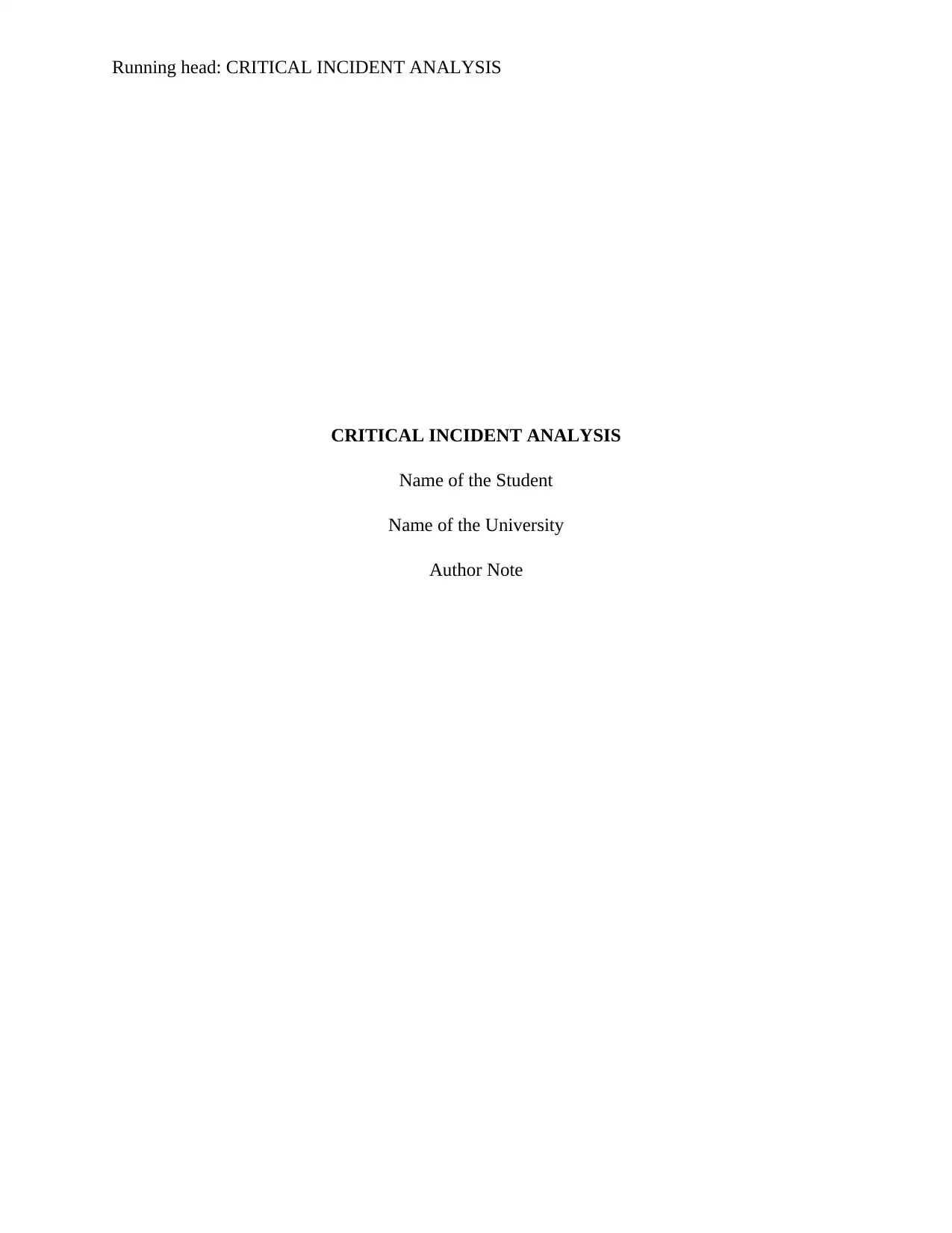
Running head: CRITICAL INCIDENT ANALYSIS
CRITICAL INCIDENT ANALYSIS
Name of the Student
Name of the University
Author Note
CRITICAL INCIDENT ANALYSIS
Name of the Student
Name of the University
Author Note
Paraphrase This Document
Need a fresh take? Get an instant paraphrase of this document with our AI Paraphraser
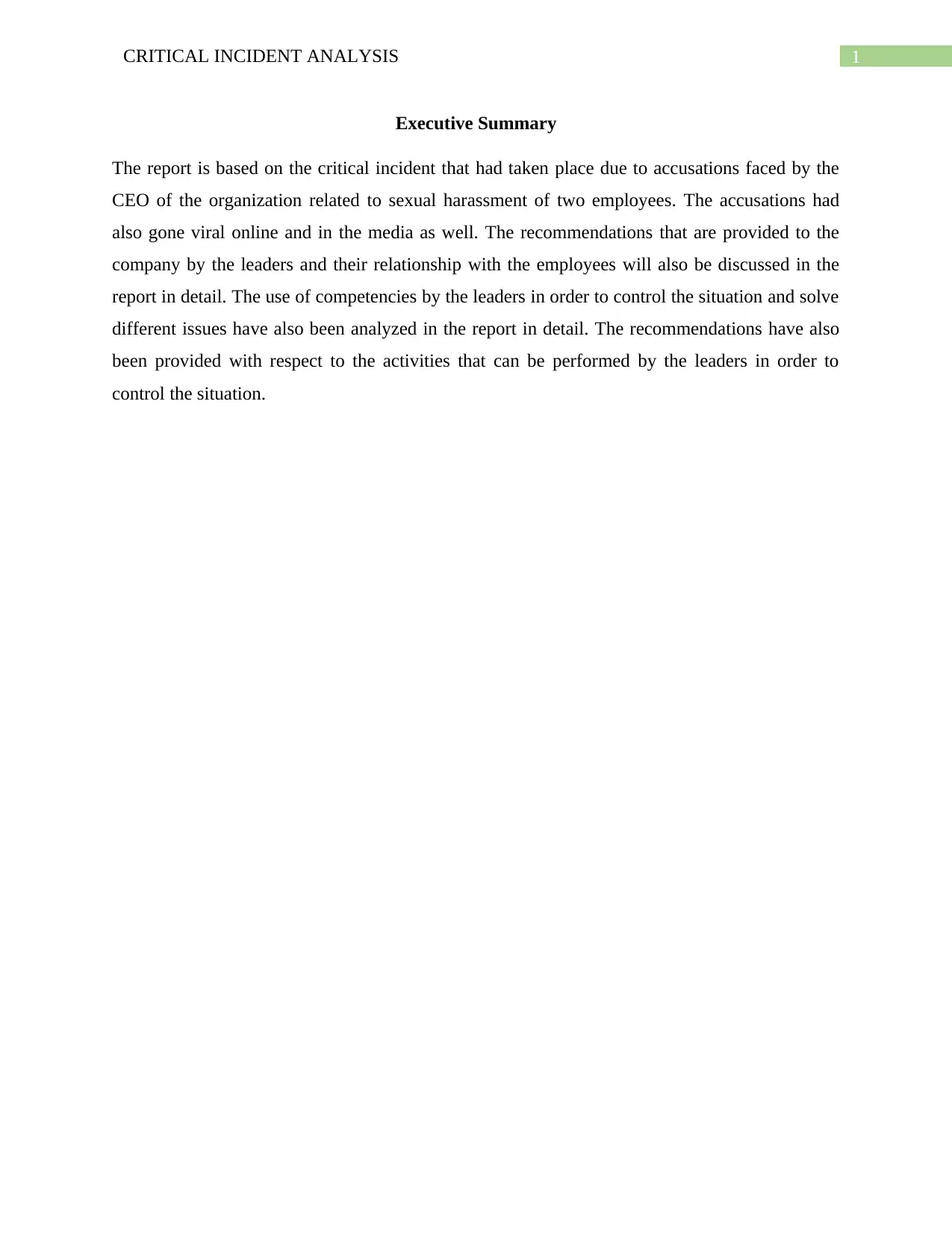
1CRITICAL INCIDENT ANALYSIS
Executive Summary
The report is based on the critical incident that had taken place due to accusations faced by the
CEO of the organization related to sexual harassment of two employees. The accusations had
also gone viral online and in the media as well. The recommendations that are provided to the
company by the leaders and their relationship with the employees will also be discussed in the
report in detail. The use of competencies by the leaders in order to control the situation and solve
different issues have also been analyzed in the report in detail. The recommendations have also
been provided with respect to the activities that can be performed by the leaders in order to
control the situation.
Executive Summary
The report is based on the critical incident that had taken place due to accusations faced by the
CEO of the organization related to sexual harassment of two employees. The accusations had
also gone viral online and in the media as well. The recommendations that are provided to the
company by the leaders and their relationship with the employees will also be discussed in the
report in detail. The use of competencies by the leaders in order to control the situation and solve
different issues have also been analyzed in the report in detail. The recommendations have also
been provided with respect to the activities that can be performed by the leaders in order to
control the situation.
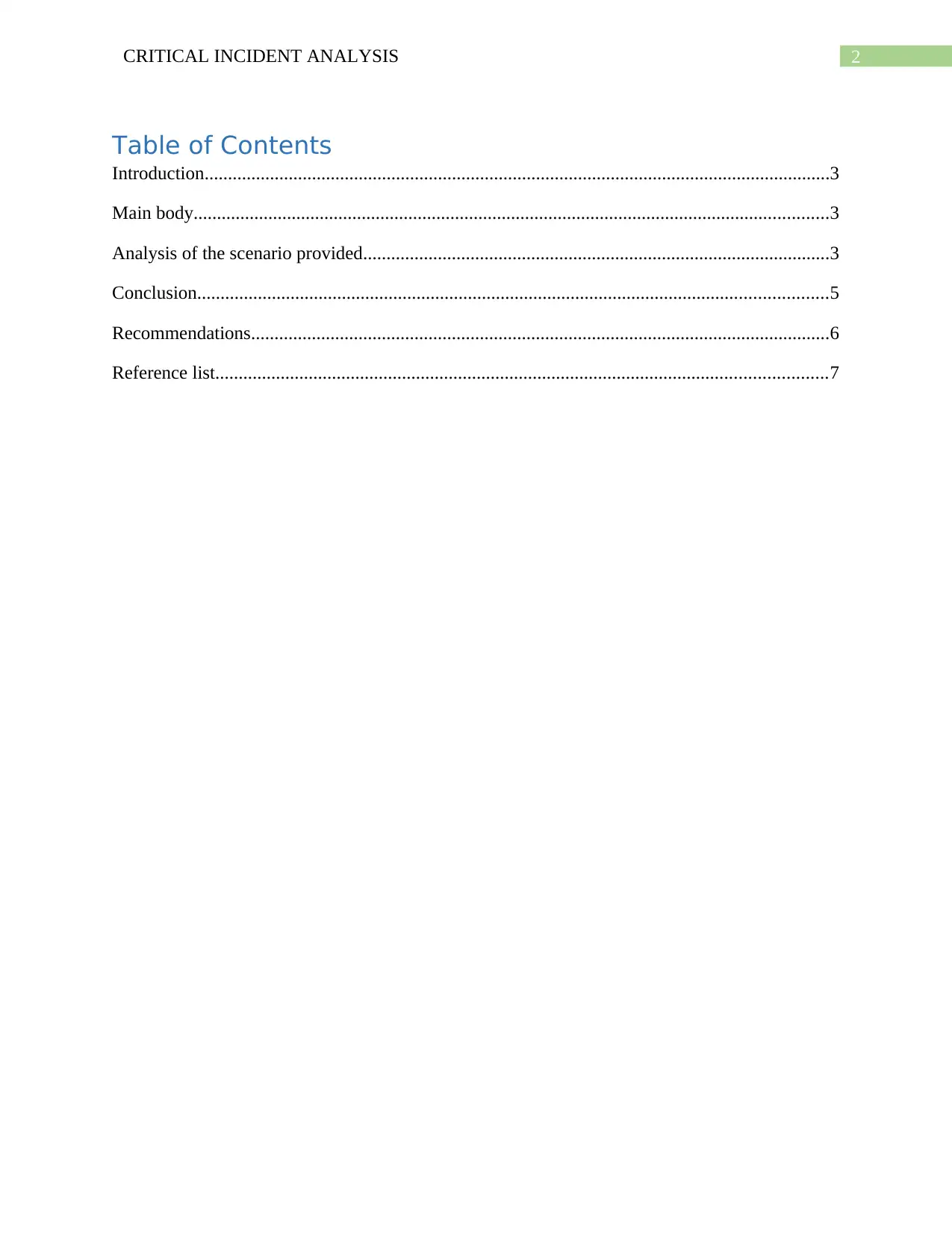
2CRITICAL INCIDENT ANALYSIS
Table of Contents
Introduction......................................................................................................................................3
Main body........................................................................................................................................3
Analysis of the scenario provided....................................................................................................3
Conclusion.......................................................................................................................................5
Recommendations............................................................................................................................6
Reference list...................................................................................................................................7
Table of Contents
Introduction......................................................................................................................................3
Main body........................................................................................................................................3
Analysis of the scenario provided....................................................................................................3
Conclusion.......................................................................................................................................5
Recommendations............................................................................................................................6
Reference list...................................................................................................................................7
⊘ This is a preview!⊘
Do you want full access?
Subscribe today to unlock all pages.

Trusted by 1+ million students worldwide
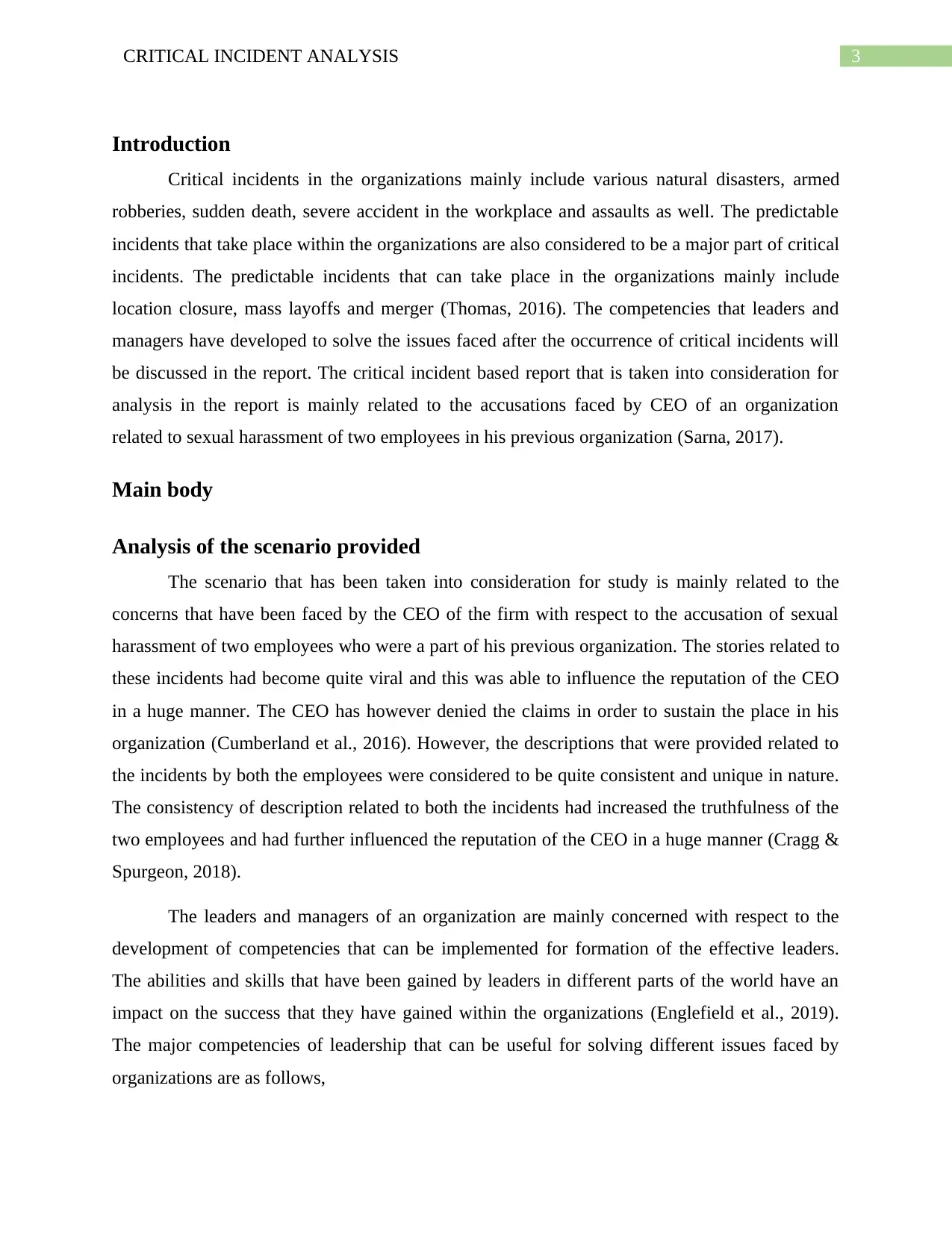
3CRITICAL INCIDENT ANALYSIS
Introduction
Critical incidents in the organizations mainly include various natural disasters, armed
robberies, sudden death, severe accident in the workplace and assaults as well. The predictable
incidents that take place within the organizations are also considered to be a major part of critical
incidents. The predictable incidents that can take place in the organizations mainly include
location closure, mass layoffs and merger (Thomas, 2016). The competencies that leaders and
managers have developed to solve the issues faced after the occurrence of critical incidents will
be discussed in the report. The critical incident based report that is taken into consideration for
analysis in the report is mainly related to the accusations faced by CEO of an organization
related to sexual harassment of two employees in his previous organization (Sarna, 2017).
Main body
Analysis of the scenario provided
The scenario that has been taken into consideration for study is mainly related to the
concerns that have been faced by the CEO of the firm with respect to the accusation of sexual
harassment of two employees who were a part of his previous organization. The stories related to
these incidents had become quite viral and this was able to influence the reputation of the CEO
in a huge manner. The CEO has however denied the claims in order to sustain the place in his
organization (Cumberland et al., 2016). However, the descriptions that were provided related to
the incidents by both the employees were considered to be quite consistent and unique in nature.
The consistency of description related to both the incidents had increased the truthfulness of the
two employees and had further influenced the reputation of the CEO in a huge manner (Cragg &
Spurgeon, 2018).
The leaders and managers of an organization are mainly concerned with respect to the
development of competencies that can be implemented for formation of the effective leaders.
The abilities and skills that have been gained by leaders in different parts of the world have an
impact on the success that they have gained within the organizations (Englefield et al., 2019).
The major competencies of leadership that can be useful for solving different issues faced by
organizations are as follows,
Introduction
Critical incidents in the organizations mainly include various natural disasters, armed
robberies, sudden death, severe accident in the workplace and assaults as well. The predictable
incidents that take place within the organizations are also considered to be a major part of critical
incidents. The predictable incidents that can take place in the organizations mainly include
location closure, mass layoffs and merger (Thomas, 2016). The competencies that leaders and
managers have developed to solve the issues faced after the occurrence of critical incidents will
be discussed in the report. The critical incident based report that is taken into consideration for
analysis in the report is mainly related to the accusations faced by CEO of an organization
related to sexual harassment of two employees in his previous organization (Sarna, 2017).
Main body
Analysis of the scenario provided
The scenario that has been taken into consideration for study is mainly related to the
concerns that have been faced by the CEO of the firm with respect to the accusation of sexual
harassment of two employees who were a part of his previous organization. The stories related to
these incidents had become quite viral and this was able to influence the reputation of the CEO
in a huge manner. The CEO has however denied the claims in order to sustain the place in his
organization (Cumberland et al., 2016). However, the descriptions that were provided related to
the incidents by both the employees were considered to be quite consistent and unique in nature.
The consistency of description related to both the incidents had increased the truthfulness of the
two employees and had further influenced the reputation of the CEO in a huge manner (Cragg &
Spurgeon, 2018).
The leaders and managers of an organization are mainly concerned with respect to the
development of competencies that can be implemented for formation of the effective leaders.
The abilities and skills that have been gained by leaders in different parts of the world have an
impact on the success that they have gained within the organizations (Englefield et al., 2019).
The major competencies of leadership that can be useful for solving different issues faced by
organizations are as follows,
Paraphrase This Document
Need a fresh take? Get an instant paraphrase of this document with our AI Paraphraser
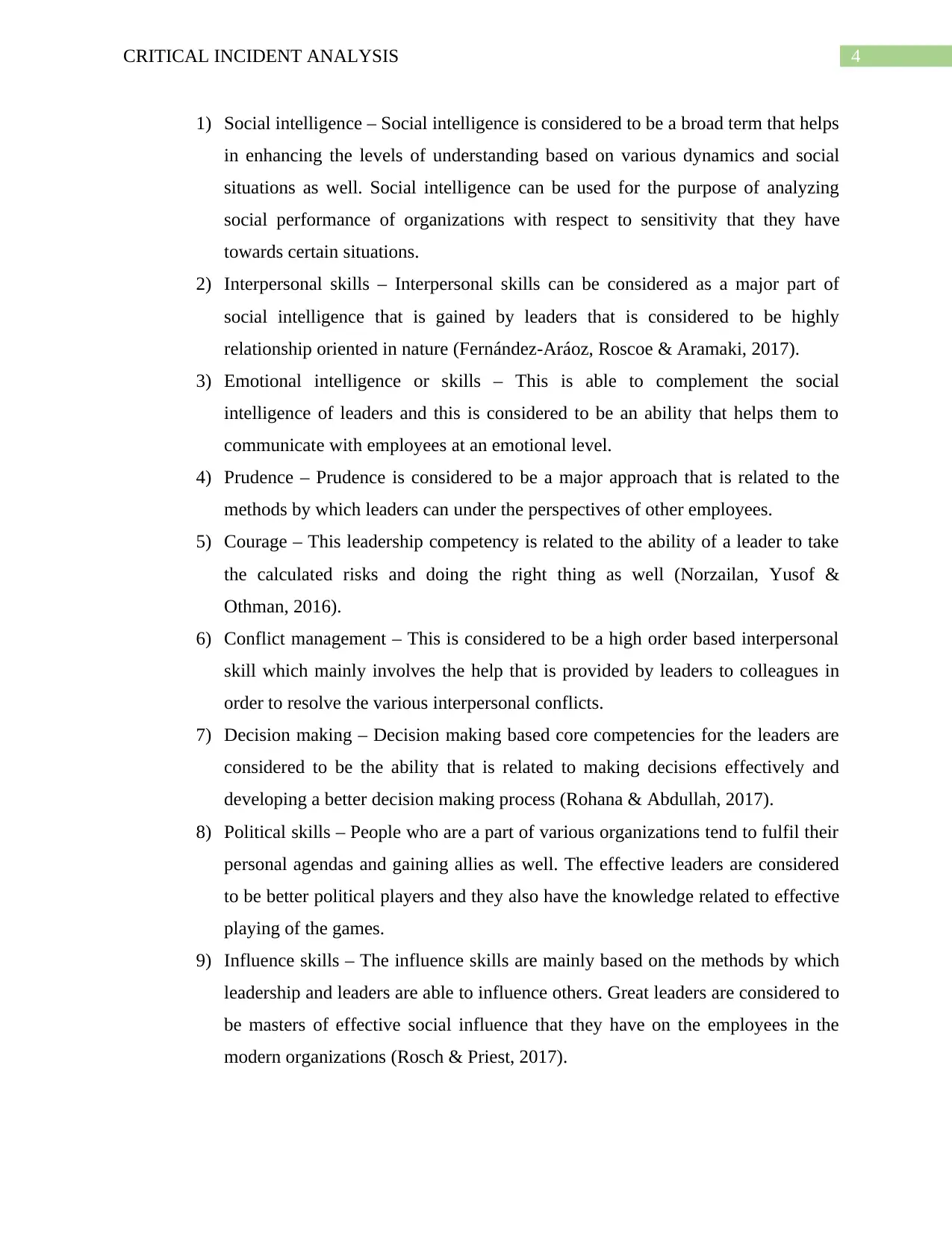
4CRITICAL INCIDENT ANALYSIS
1) Social intelligence – Social intelligence is considered to be a broad term that helps
in enhancing the levels of understanding based on various dynamics and social
situations as well. Social intelligence can be used for the purpose of analyzing
social performance of organizations with respect to sensitivity that they have
towards certain situations.
2) Interpersonal skills – Interpersonal skills can be considered as a major part of
social intelligence that is gained by leaders that is considered to be highly
relationship oriented in nature (Fernández-Aráoz, Roscoe & Aramaki, 2017).
3) Emotional intelligence or skills – This is able to complement the social
intelligence of leaders and this is considered to be an ability that helps them to
communicate with employees at an emotional level.
4) Prudence – Prudence is considered to be a major approach that is related to the
methods by which leaders can under the perspectives of other employees.
5) Courage – This leadership competency is related to the ability of a leader to take
the calculated risks and doing the right thing as well (Norzailan, Yusof &
Othman, 2016).
6) Conflict management – This is considered to be a high order based interpersonal
skill which mainly involves the help that is provided by leaders to colleagues in
order to resolve the various interpersonal conflicts.
7) Decision making – Decision making based core competencies for the leaders are
considered to be the ability that is related to making decisions effectively and
developing a better decision making process (Rohana & Abdullah, 2017).
8) Political skills – People who are a part of various organizations tend to fulfil their
personal agendas and gaining allies as well. The effective leaders are considered
to be better political players and they also have the knowledge related to effective
playing of the games.
9) Influence skills – The influence skills are mainly based on the methods by which
leadership and leaders are able to influence others. Great leaders are considered to
be masters of effective social influence that they have on the employees in the
modern organizations (Rosch & Priest, 2017).
1) Social intelligence – Social intelligence is considered to be a broad term that helps
in enhancing the levels of understanding based on various dynamics and social
situations as well. Social intelligence can be used for the purpose of analyzing
social performance of organizations with respect to sensitivity that they have
towards certain situations.
2) Interpersonal skills – Interpersonal skills can be considered as a major part of
social intelligence that is gained by leaders that is considered to be highly
relationship oriented in nature (Fernández-Aráoz, Roscoe & Aramaki, 2017).
3) Emotional intelligence or skills – This is able to complement the social
intelligence of leaders and this is considered to be an ability that helps them to
communicate with employees at an emotional level.
4) Prudence – Prudence is considered to be a major approach that is related to the
methods by which leaders can under the perspectives of other employees.
5) Courage – This leadership competency is related to the ability of a leader to take
the calculated risks and doing the right thing as well (Norzailan, Yusof &
Othman, 2016).
6) Conflict management – This is considered to be a high order based interpersonal
skill which mainly involves the help that is provided by leaders to colleagues in
order to resolve the various interpersonal conflicts.
7) Decision making – Decision making based core competencies for the leaders are
considered to be the ability that is related to making decisions effectively and
developing a better decision making process (Rohana & Abdullah, 2017).
8) Political skills – People who are a part of various organizations tend to fulfil their
personal agendas and gaining allies as well. The effective leaders are considered
to be better political players and they also have the knowledge related to effective
playing of the games.
9) Influence skills – The influence skills are mainly based on the methods by which
leadership and leaders are able to influence others. Great leaders are considered to
be masters of effective social influence that they have on the employees in the
modern organizations (Rosch & Priest, 2017).
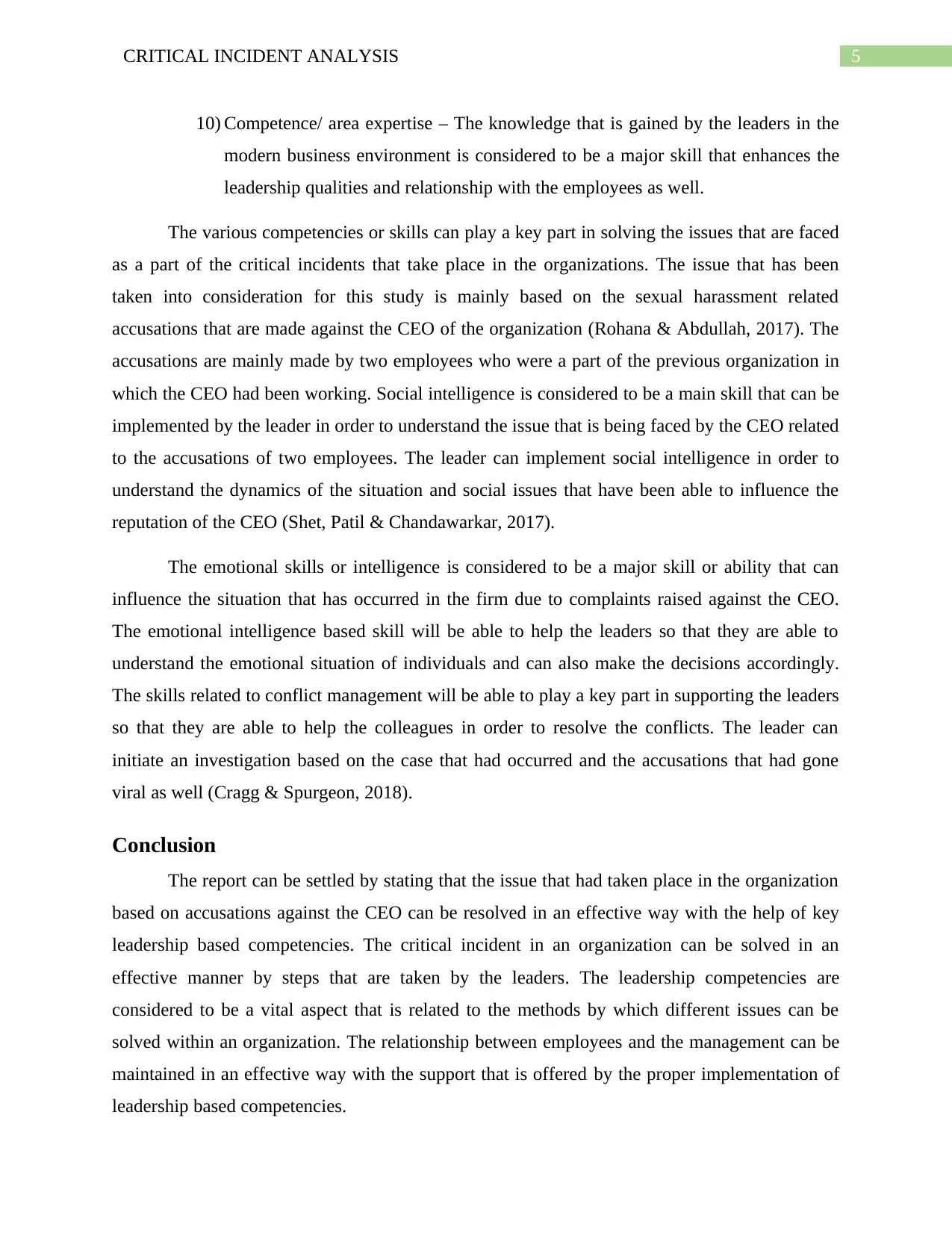
5CRITICAL INCIDENT ANALYSIS
10) Competence/ area expertise – The knowledge that is gained by the leaders in the
modern business environment is considered to be a major skill that enhances the
leadership qualities and relationship with the employees as well.
The various competencies or skills can play a key part in solving the issues that are faced
as a part of the critical incidents that take place in the organizations. The issue that has been
taken into consideration for this study is mainly based on the sexual harassment related
accusations that are made against the CEO of the organization (Rohana & Abdullah, 2017). The
accusations are mainly made by two employees who were a part of the previous organization in
which the CEO had been working. Social intelligence is considered to be a main skill that can be
implemented by the leader in order to understand the issue that is being faced by the CEO related
to the accusations of two employees. The leader can implement social intelligence in order to
understand the dynamics of the situation and social issues that have been able to influence the
reputation of the CEO (Shet, Patil & Chandawarkar, 2017).
The emotional skills or intelligence is considered to be a major skill or ability that can
influence the situation that has occurred in the firm due to complaints raised against the CEO.
The emotional intelligence based skill will be able to help the leaders so that they are able to
understand the emotional situation of individuals and can also make the decisions accordingly.
The skills related to conflict management will be able to play a key part in supporting the leaders
so that they are able to help the colleagues in order to resolve the conflicts. The leader can
initiate an investigation based on the case that had occurred and the accusations that had gone
viral as well (Cragg & Spurgeon, 2018).
Conclusion
The report can be settled by stating that the issue that had taken place in the organization
based on accusations against the CEO can be resolved in an effective way with the help of key
leadership based competencies. The critical incident in an organization can be solved in an
effective manner by steps that are taken by the leaders. The leadership competencies are
considered to be a vital aspect that is related to the methods by which different issues can be
solved within an organization. The relationship between employees and the management can be
maintained in an effective way with the support that is offered by the proper implementation of
leadership based competencies.
10) Competence/ area expertise – The knowledge that is gained by the leaders in the
modern business environment is considered to be a major skill that enhances the
leadership qualities and relationship with the employees as well.
The various competencies or skills can play a key part in solving the issues that are faced
as a part of the critical incidents that take place in the organizations. The issue that has been
taken into consideration for this study is mainly based on the sexual harassment related
accusations that are made against the CEO of the organization (Rohana & Abdullah, 2017). The
accusations are mainly made by two employees who were a part of the previous organization in
which the CEO had been working. Social intelligence is considered to be a main skill that can be
implemented by the leader in order to understand the issue that is being faced by the CEO related
to the accusations of two employees. The leader can implement social intelligence in order to
understand the dynamics of the situation and social issues that have been able to influence the
reputation of the CEO (Shet, Patil & Chandawarkar, 2017).
The emotional skills or intelligence is considered to be a major skill or ability that can
influence the situation that has occurred in the firm due to complaints raised against the CEO.
The emotional intelligence based skill will be able to help the leaders so that they are able to
understand the emotional situation of individuals and can also make the decisions accordingly.
The skills related to conflict management will be able to play a key part in supporting the leaders
so that they are able to help the colleagues in order to resolve the conflicts. The leader can
initiate an investigation based on the case that had occurred and the accusations that had gone
viral as well (Cragg & Spurgeon, 2018).
Conclusion
The report can be settled by stating that the issue that had taken place in the organization
based on accusations against the CEO can be resolved in an effective way with the help of key
leadership based competencies. The critical incident in an organization can be solved in an
effective manner by steps that are taken by the leaders. The leadership competencies are
considered to be a vital aspect that is related to the methods by which different issues can be
solved within an organization. The relationship between employees and the management can be
maintained in an effective way with the support that is offered by the proper implementation of
leadership based competencies.
⊘ This is a preview!⊘
Do you want full access?
Subscribe today to unlock all pages.

Trusted by 1+ million students worldwide
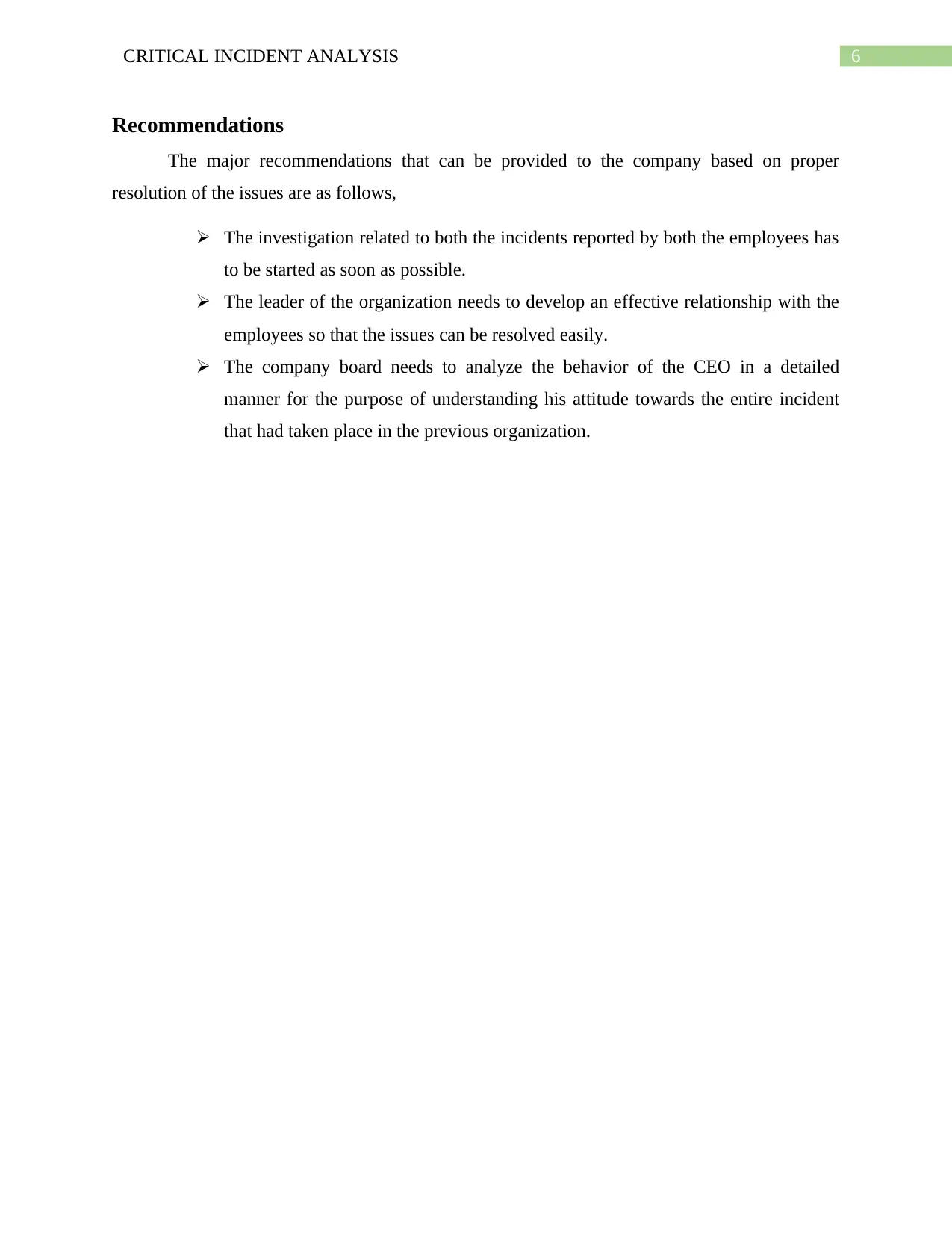
6CRITICAL INCIDENT ANALYSIS
Recommendations
The major recommendations that can be provided to the company based on proper
resolution of the issues are as follows,
The investigation related to both the incidents reported by both the employees has
to be started as soon as possible.
The leader of the organization needs to develop an effective relationship with the
employees so that the issues can be resolved easily.
The company board needs to analyze the behavior of the CEO in a detailed
manner for the purpose of understanding his attitude towards the entire incident
that had taken place in the previous organization.
Recommendations
The major recommendations that can be provided to the company based on proper
resolution of the issues are as follows,
The investigation related to both the incidents reported by both the employees has
to be started as soon as possible.
The leader of the organization needs to develop an effective relationship with the
employees so that the issues can be resolved easily.
The company board needs to analyze the behavior of the CEO in a detailed
manner for the purpose of understanding his attitude towards the entire incident
that had taken place in the previous organization.
Paraphrase This Document
Need a fresh take? Get an instant paraphrase of this document with our AI Paraphraser
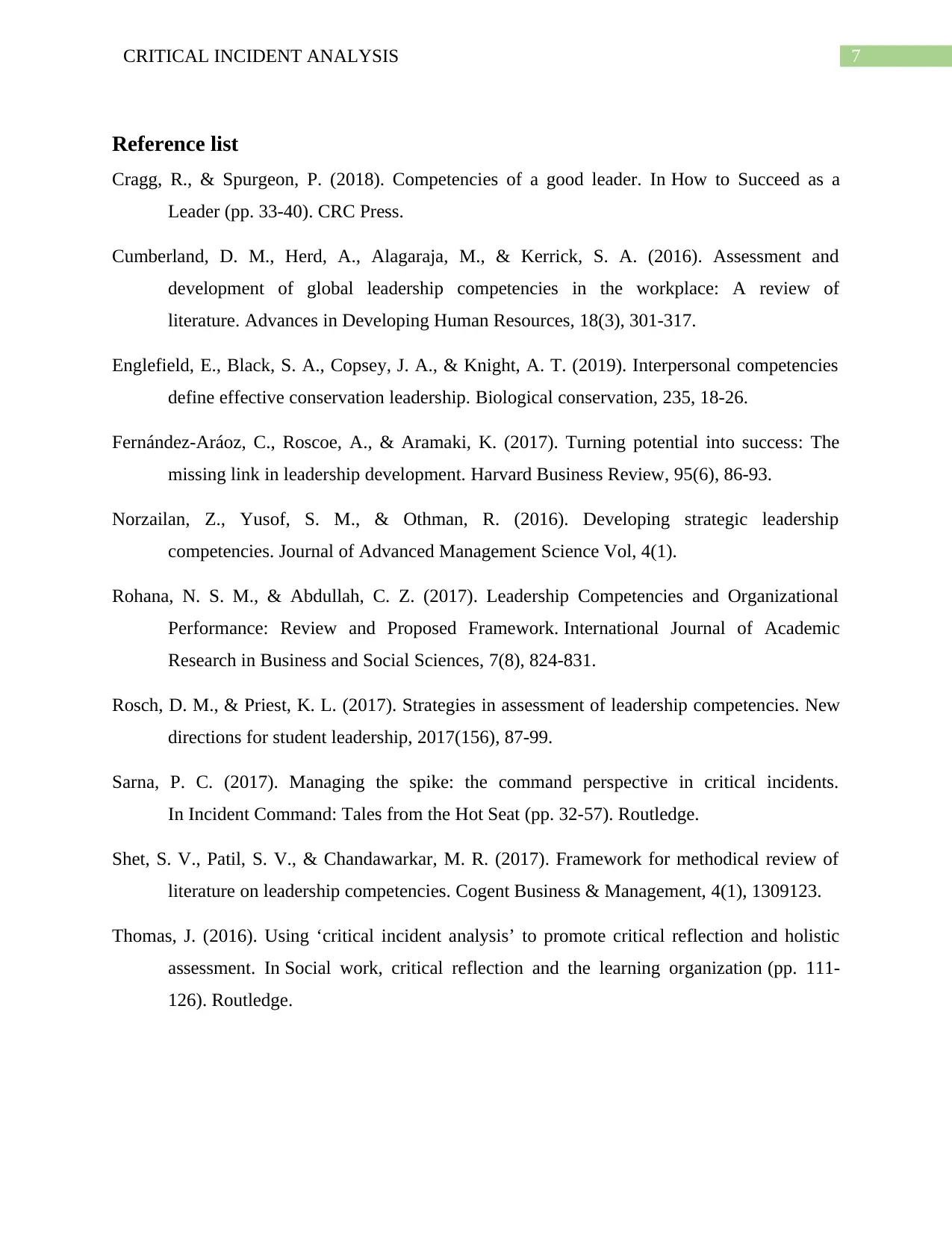
7CRITICAL INCIDENT ANALYSIS
Reference list
Cragg, R., & Spurgeon, P. (2018). Competencies of a good leader. In How to Succeed as a
Leader (pp. 33-40). CRC Press.
Cumberland, D. M., Herd, A., Alagaraja, M., & Kerrick, S. A. (2016). Assessment and
development of global leadership competencies in the workplace: A review of
literature. Advances in Developing Human Resources, 18(3), 301-317.
Englefield, E., Black, S. A., Copsey, J. A., & Knight, A. T. (2019). Interpersonal competencies
define effective conservation leadership. Biological conservation, 235, 18-26.
Fernández-Aráoz, C., Roscoe, A., & Aramaki, K. (2017). Turning potential into success: The
missing link in leadership development. Harvard Business Review, 95(6), 86-93.
Norzailan, Z., Yusof, S. M., & Othman, R. (2016). Developing strategic leadership
competencies. Journal of Advanced Management Science Vol, 4(1).
Rohana, N. S. M., & Abdullah, C. Z. (2017). Leadership Competencies and Organizational
Performance: Review and Proposed Framework. International Journal of Academic
Research in Business and Social Sciences, 7(8), 824-831.
Rosch, D. M., & Priest, K. L. (2017). Strategies in assessment of leadership competencies. New
directions for student leadership, 2017(156), 87-99.
Sarna, P. C. (2017). Managing the spike: the command perspective in critical incidents.
In Incident Command: Tales from the Hot Seat (pp. 32-57). Routledge.
Shet, S. V., Patil, S. V., & Chandawarkar, M. R. (2017). Framework for methodical review of
literature on leadership competencies. Cogent Business & Management, 4(1), 1309123.
Thomas, J. (2016). Using ‘critical incident analysis’ to promote critical reflection and holistic
assessment. In Social work, critical reflection and the learning organization (pp. 111-
126). Routledge.
Reference list
Cragg, R., & Spurgeon, P. (2018). Competencies of a good leader. In How to Succeed as a
Leader (pp. 33-40). CRC Press.
Cumberland, D. M., Herd, A., Alagaraja, M., & Kerrick, S. A. (2016). Assessment and
development of global leadership competencies in the workplace: A review of
literature. Advances in Developing Human Resources, 18(3), 301-317.
Englefield, E., Black, S. A., Copsey, J. A., & Knight, A. T. (2019). Interpersonal competencies
define effective conservation leadership. Biological conservation, 235, 18-26.
Fernández-Aráoz, C., Roscoe, A., & Aramaki, K. (2017). Turning potential into success: The
missing link in leadership development. Harvard Business Review, 95(6), 86-93.
Norzailan, Z., Yusof, S. M., & Othman, R. (2016). Developing strategic leadership
competencies. Journal of Advanced Management Science Vol, 4(1).
Rohana, N. S. M., & Abdullah, C. Z. (2017). Leadership Competencies and Organizational
Performance: Review and Proposed Framework. International Journal of Academic
Research in Business and Social Sciences, 7(8), 824-831.
Rosch, D. M., & Priest, K. L. (2017). Strategies in assessment of leadership competencies. New
directions for student leadership, 2017(156), 87-99.
Sarna, P. C. (2017). Managing the spike: the command perspective in critical incidents.
In Incident Command: Tales from the Hot Seat (pp. 32-57). Routledge.
Shet, S. V., Patil, S. V., & Chandawarkar, M. R. (2017). Framework for methodical review of
literature on leadership competencies. Cogent Business & Management, 4(1), 1309123.
Thomas, J. (2016). Using ‘critical incident analysis’ to promote critical reflection and holistic
assessment. In Social work, critical reflection and the learning organization (pp. 111-
126). Routledge.
1 out of 8
Related Documents
Your All-in-One AI-Powered Toolkit for Academic Success.
+13062052269
info@desklib.com
Available 24*7 on WhatsApp / Email
![[object Object]](/_next/static/media/star-bottom.7253800d.svg)
Unlock your academic potential
Copyright © 2020–2025 A2Z Services. All Rights Reserved. Developed and managed by ZUCOL.





